Abstract
Sodium-ion batteries (SIB) are gaining attention as a sustainable, cost-effective alternative to lithium-ion technology in electric vehicles (EVs), driven by concerns over lithium’s scarcity, high costs, and environmental impact. This study explores the feasibility of SIBs through a theoretical analysis of recent advancements in chemistry, materials, and electrochemical performance. It compares key factors such as energy density, charge cycles, safety, cost-effectiveness, and supply chain sustainability. While sodium-ion batteries currently offer lower energy density and shorter cycle life, they benefit from abundant raw materials and more sustainable production. Recent breakthroughs in electrode and electrolyte design show promise for improved efficiency and longevity. Sodium-ion technology is not yet a full replacement for Li-ion batteries but presents a viable option for low-cost EVs and stationary storage.
1. Introduction
Energy storage systems are defined as technologies designed to capture and store energy produced at one time for use later, effectively bridging the gap between intermittent energy generation and variable demand. In modern power grids, these systems are rapidly transitioning from supplementary components to indispensable elements, crucial for ensuring consistent energy supply and overall grid stability [,].
The growing global demand for storing energy is not merely a passing trend but a profound and fundamental shift in the energy landscape, underscored by compelling quantitative evidence. The energy sector now accounts for over 90% of total lithium battery demand, highlighting its central role in driving battery technology adoption and market growth. In 2023, battery storage emerged as the fastest-growing commercially available energy technology within the electricity sector, with global deployments increasing by 42 gigawatts (GW), representing an impressive surge of over 130% compared to the previous year. This rapid acceleration demonstrates the immediate and critical relevance of energy storage and battery technology [].
While lithium-ion batteries (LIBs) currently dominate high-performance applications, their widespread adoption faces increasing scrutiny due to several pressing challenges. These include critical mineral scarcity, particularly concerning lithium and cobalt, and the high environmental impact associated with their extraction and processing. Furthermore, limited recyclability and significant geopolitical risks linked to complex supply chains pose substantial long-term sustainability and security concerns, as highlighted by different publications [,,]. These growing limitations underscore the urgent necessity of exploring alternative battery chemistries. Consequently, increasing global interest in SIBs reflected in geographic search trends and supported by sustainability goals signals a growing role for sodium-based solutions in cost-sensitive and regionally constrained energy markets. This study explores how public perception, material availability, and technological advancements converge to shape the future of battery adoption, particularly in light of these challenges.
2. Materials and Methods
Recent research has made significant strides in enhancing the performance, safety, and economic viability of SIBs, revealing the complex interplay between material properties, design strategies, and market conditions. One study demonstrated that applying uniaxial pressure during sodium plating and stripping significantly affects initial coulombic efficiency, with an optimal pressure identified for each electrolyte type. Ether-based systems yielded thinner and denser solid electrolyte interphase (SEI) layers compared to carbonate-based ones, underlining the importance of solvent choice and applied pressure for long-term performance, achieving high capacity retention and discharge at elevated current rates []. Complementing this, a multiphysics modeling study provided insights into how design parameters influence performance and cost for energy versus power applications. It showed that while energy cells are cheaper due to thicker electrodes, shifting to power applications increases material costs, especially for separators, suggesting future cost-reduction efforts should target these components. Notably, SIBs demonstrate a marginal cost advantage over Lithium Iron Phosphate (LFP) based LIBs, though electrochemical improvements remain necessary to unlock full potential [].
Another comprehensive modeling framework analyzed 6048 market scenarios to assess when sodium-ion technologies might achieve price parity or advantage over lithium-based counterparts. The study emphasized the strong influence of supply chain disruptions—such as rising lithium or graphite prices—on accelerating sodium competitiveness. It found that techno-economic advancement depends less on cost-learning from scale and more on targeted improvements in energy density, specific capacities, and electrode architecture, especially for hard carbon anodes and layered oxide cathodes. Alternative approaches such as anode-free configurations and alloy-based anodes offer promise but come with trade-offs in cost and performance trajectory, reinforcing the need for proactive roadmap-driven research over passive market-led evolution []. In parallel, developments in solid-state SIBs focus on overcoming challenges such as dendrite suppression and solid electrolyte compatibility. Progress in superionic conductors and polymer systems shows promise for high ionic mobility, while innovations in electrode design and interfacial engineering are critical for achieving stable, high-density storage systems for commercial applications [].
Despite their growing viability, SIBs still face fundamental limitations in energy density and cycle life compared to LIBs. However, their superior safety, abundance, and resilience in extreme conditions—such as low temperatures where LIBs fail—position them as a strategic complement rather than a direct replacement. A hybrid system leveraging the strengths of both could optimize performance across varied use scenarios []. Finally, while polyanionic cathodes have proven advantageous due to their thermal stability and specific energy, reliance on costly vanadium-based materials limits their scalability. The focus is shifting toward alternatives that are rich in manganese and iron, which are more abundant and cost-effective. However, safety concerns—particularly regarding the potential for toxic gas release from Prussian-blue analogues—necessitate deeper investigations into thermal behavior and stability at both the material and system levels to ensure safe deployment, particularly in stationary applications []. Recent breakthrough also shows that manufacturer CATL achieved energy densities exceeding 200 Wh/kg which leverages the competitiveness [].
The global SIB market is undergoing significant expansion, fueled by the increasing demand for affordable and environmentally sustainable energy storage solutions. In 2024, the market was valued at USD 270.1 million and is expected to grow at a compound annual growth rate (CAGR) of 26.1% from 2025 to 2034. This rapid growth is driven by several key factors. The market is also benefiting from substantial research and development investments aimed at overcoming existing performance limitations. For instance, the U.S. Department of Energy, through its partnership with the LENS Consortium, has committed USD 50 million over five years to accelerate SIB innovation. These efforts are focused on improving the energy density and cycle life of SIBs to make them more competitive with lithium-based alternatives [].
My research uses Google Trends database and utilizes a search popularity index scaled from 0 to 100. A value of 100 signifies the location with the highest relative popularity for the queried term, normalized against the total search volume. A value of 50 indicates that the popularity in that location is half of the peak observed popularity. A 0 signifies insufficient data for reliable measurement. It is crucial to understand that higher values in geographic and popularity charts represent a greater proportion of total queries, rather than a higher absolute number of queries. This methodology enables precise comparisons of relative popularity across different regions or timeframes.
Sustainability and Policy Context
The European Union has taken a leading role in supporting sustainable and locally sourced energy storage solutions, including SIBs. EU Green Deal policies, along with the Battery Regulation (EU 2023/1542) [], promote environmentally friendly battery technologies and lifecycle traceability. SIBs are gaining interest as a safer, cheaper alternative to lithium-based options, especially given Europe’s limited lithium reserves and growing pressure to reduce dependency on third-country suppliers. Horizon Europe and the European Battery Alliance offer significant funding for R&D in alternative chemistries. The EU’s goal of achieving climate neutrality by 2050 further strengthens political and financial support for sustainable battery technologies like sodium-ion batteries. These two phrases with Lithium together are reaching records in search terms all around the world (Figure 1).
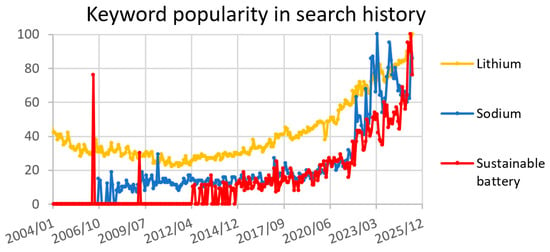
Figure 1.
This figure shows the popularity in search history for the three main keywords my paper analyses.
In the United States, growing concerns over supply chain security and sustainability are driving interest in SIB development. Sodium is widely available domestically, reducing reliance on imports for critical materials like lithium and cobalt. The U.S. Department of Energy has actively supported sodium-based battery research through initiatives like the LIFT and LENS Consortia, with tens of millions of dollars allocated to advanced battery innovation. Moreover, the Bipartisan Infrastructure Law and Inflation Reduction Act includes funding and tax incentives for sustainable energy storage systems, explicitly supporting next-generation battery chemistries. The U.S. also emphasizes environmental justice and circular economy principles.
China is at the forefront of SIB research and deployment, backed by robust industrial policy and state-supported innovation programs. With limited domestic lithium reserves but abundant sodium resources, Chinese policymakers have strategically pivoted to sodium-ion technology to reduce dependency on imported lithium and cobalt. The Chinese government’s 14th Five-Year Plan and Made in China 2025 initiative both prioritize new energy technologies, including SIBs. CATL and HiNa Battery have launched commercial-scale sodium-ion products with state aid and favorable public procurement policies. Additionally, China’s commitment to peak carbon by 2030 and carbon neutrality by 2060 encourages the rapid commercialization of environmentally friendlier batteries.
Australia has abundant reserves of sodium-bearing minerals, including soda ash and halite, positioning it as a strategic resource hub for SIB supply chains. The Australian Government’s Critical Minerals Strategy emphasizes diversification away from lithium and rare earths dependency, encouraging investment in alternative chemistries like sodium. Programs such as the Modern Manufacturing Initiative and the National Reconstruction Fund provide funding for advanced battery technologies, including sodium-based systems. Moreover, Australia’s alignment with global climate goals—such as net-zero by 2050—drives both public and private investment in low-emission technologies.
3. Results
My geographic and search trend analysis showed a substantial correlation between market interest and technology research. As geographical data shows in Figure 2 the linked keywords are most popular, where connected activity is involved. While China is highlighted in Figure 2a as a leading R&D area for SIB related search, Figure 2b shows that in Australia and Zimbabwe the mining industry is leading the searches for LIB.
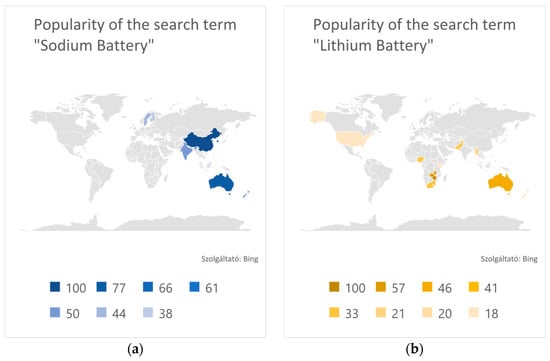
Figure 2.
This figure presents the top 10 geographical distribution in the last 12 months search history about keywords. (a) Popularity of “Sodium Battery” keyword compared to the total number of searches and (b) Popularity of “Lithium Battery” keyword compared to the total number of searches.
Confirming my previous geographic distribution, the level of financial support represented in Figure 3 towards SIBs also shows broad similarity to the regional pattern of the search term popularity in the case of China.
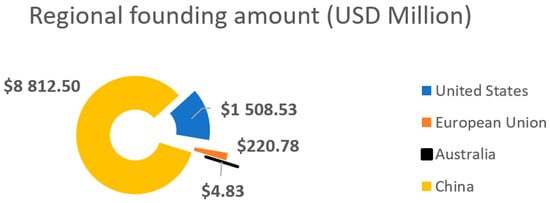
Figure 3.
This figure shows the allocated founding for Sodium based battery R&D from 2023 to nowadays for the analyzed regions.
As salt becomes more and more useful and integrated into industrial and battery manufacturing applications, its popularity as a keyword is also increasing, which is backed by my popularity analysis between lithium and sodium below on Figure 4.
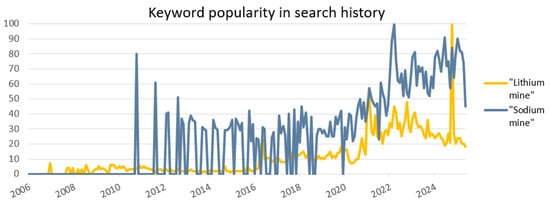
Figure 4.
This figure shows the search popularity comparison between “Lithium mine” and “Sodium mine” worldwide.
My research also shows that despite the fact that the R&D and materials sector is now involved in sodium-based batteries, their economic value is stagnating, as Figure 5 shows. This is most likely because of this material is widely found on earth and can be easily integrated into the circular economy unlike lithium.
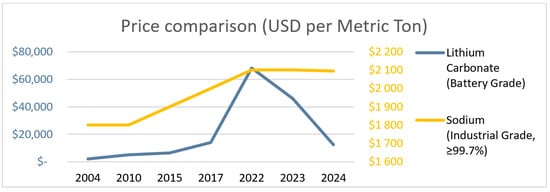
Figure 5.
This figure shows the comparison between lithium and sodium prices from 2004 to date.
4. Discussion
The wide accessibility and low cost of raw materials for SIBs remain a significant long-term advantage, offering a pathway to reduced overall costs and greater supply chain stability. Enhanced safety features, such as non-flammable electrolytes and the ability to be fully discharged without damage, make them particularly attractive for large-scale grid storage and certain industrial applications where safety is the number one factor. Their suitability for cost-sensitive applications and urban electric vehicles, where energy density is less critical than cost and safety, presents a substantial market opportunity. Moreover, the ability to adapt the existing lithium-ion manufacturing infrastructure with minimal modifications offers a pathway for faster scaling and reduced capital expenditure compared to entirely new production lines.
The significant global investments in SIBs are not solely dependent on achieving immediate cost superiority over lithium-ion batteries, especially given the volatile nature of lithium prices. Instead, these investments represent a strategic long-term commitment to the inherent advantages of sodium-ion batteries: resource abundance, supply chain stability (thereby reducing geopolitical risks), enhanced safety, and suitability for specific applications like grid-scale storage and urban mobility where energy density is less of a limiting factor. The current investments are aimed at driving down costs through economies of scale and technological maturity over time, rather than waiting for natural market forces to make them immediately cheaper than all lithium-ion variants. This proactive investment is shaping the future of global energy storage, reflecting a forward-looking strategy by nations and major corporations to build resilience and sustainability into their energy systems, prioritizing long-term strategic benefits over short-term market fluctuations in raw material costs.
5. Conclusions
SIBs are emerging as a viable and increasingly competitive alternative to lithium-ion technologies, driven by both resource availability and global sustainability imperatives. This research has explored the technical, economic, and policy-related dimensions of SIBs, demonstrating that while lithium-based cells continue to dominate in terms of energy density, sodium-ion batteries exhibit significant advantages in material cost, safety, and environmental impact. The raw material for SIBs, sodium, is approximately 80% cheaper, far more abundant and easier connected into circular economy than lithium, leading to price stability and reduced geopolitical risk.
Technologically, current sodium-based cells are still behind lithium-based cells in terms of energy density by roughly 40%. However, ongoing breakthroughs in electrode materials, solid electrolytes, and cathode composition are rapidly narrowing this gap. Recent publications suggest notable progress in sodium-ion cycle life and energy efficiency, supporting their future use in both stationary storage and cost-sensitive electric mobility applications.
My research has supported the thesis that with technological advances and financial measures to stimulate the economy and R&D, sodium-based batteries are gaining ground and all of these have a constant correlation with worldwide search history.
Funding
Project no. TKP2021-NVA-23 has been implemented with the support provided by the Ministry of Technology and Industry of Hungary from the National Research, Development and Innovation Fund, financed under the TKP2021-NVA funding scheme.
Institutional Review Board Statement
Not applicable.
Informed Consent Statement
Not applicable.
Data Availability Statement
The raw data supporting the conclusions of this article will be made available by the author on request.
Conflicts of Interest
The funders had no role in the design of the study; in the collection, analyses, or interpretation of data; in the writing of the manuscript; or in the decision to publish the results.
References
- Energy Storage Technologies: Reducing Costs and Increasing Efficiency for Industries. Available online: https://www.galacticadvisors.com/research/energy-storage-technologies-reducing-costs-and-increasing-efficiency-for-industries/ (accessed on 22 July 2025).
- Research and Markets. Stationary Battery Storage Market Opportunity, Growth Drivers, Industry Trend Analysis, and Forecast 2025–2034. Available online: https://www.globenewswire.com/news-release/2025/04/28/3068944/28124/en/Stationary-Battery-Storage-Market-Industry-Trends-Key-Growth-Drivers-Challenges-Future-Opportunities-and-Regulatory-Landscape-Forecasts-to-2034.html (accessed on 22 July 2025).
- IEA. Batteries and Secure Energy Transitions; International Energy Agency: Paris, France, 2024; Available online: https://www.iea.org/reports/batteries-and-secure-energy-transitions (accessed on 22 July 2025).
- Aishwarya, V.M.; Ekren, B.Y.; Singh, T.; Singh, V. Integrating Sustainability across the Lifecycle of Electric Vehicle Batteries: Circular Supply Chain Challenges, Innovations, and Global Policy Impacts. Renew. Sustain. Energy Rev. 2025, 216, 115671. [Google Scholar] [CrossRef]
- Zheng, P.; Young, D.; Yang, T.; Xiao, Y.; Li, Z. Powering Battery Sustainability: A Review of the Recent Progress and Evolving Challenges in Recycling Lithium-Ion Batteries. Front. Sustain. Resour. Manag. 2023, 2, 1127001. [Google Scholar] [CrossRef]
- Kim, H.C.; Wallington, T.J.; Arsenault, R.; Bae, C.; Ahn, S.; Lee, J. Cradle-to-Gate Emissions from a Commercial Electric Vehicle Li-Ion Battery: A Comparative Analysis. Environ. Sci. Technol. 2016, 50, 7715–7722. [Google Scholar] [CrossRef] [PubMed]
- Sayahpour, B.; Li, W.; Bai, S.; Lu, B.; Han, B.; Chen, Y.T.; Deysher, G.; Parab, S.; Ridley, P.; Raghavendran, G.; et al. Quantitative Analysis of Sodium Metal Deposition and Interphase in Na Metal Batteries. Energy Environ. Sci. 2024, 17, 1216–1228. [Google Scholar] [CrossRef]
- Domalanta, M.R.B.; Castro, M.T.; Del Rosario, J.A.D.; Ocon, J.D. Cost Analysis of a Sodium-Ion Battery Pack for Energy and Power Applications Using Combined Multi-Physics and Techno-Economic Modeling. Chem. Eng. Trans. 2022, 94, 139–144. [Google Scholar] [CrossRef]
- Yao, A.; Benson, S.M.; Chueh, W.C. How Quickly Can Sodium-Ion Learn? Assessing Scenarios for Techno-Economic Competitiveness Against Lithium-Ion Batteries. arXiv 2024, arXiv:2403.13759. [Google Scholar] [CrossRef]
- Massaro, A.; Squillantini, L.; De Giorgio, F.; Scaramuzzo, F.A.; Pasquali, M.; Brutti, S. Advancements in Solid-State Sodium-Based Batteries: A Comprehensive Review. arXiv 2025, arXiv:2505.04391. [Google Scholar] [CrossRef]
- Hu, F.; Lin, H.; Pan, R. Feasibility Analysis of Replacing Lithium-Ion Battery with Sodium-Ion Battery. Highlights Sci. Eng. Technol. 2024, 90, 81–86. [Google Scholar] [CrossRef]
- Kim, H. Sodium-Ion Battery: Can It Compete with Li-Ion? ACS Mater. Au 2023, 3, 571–575. [Google Scholar] [CrossRef] [PubMed]
- Guo, W.; Feng, T.; Li, W.; Hua, L.; Meng, Z.; Li, K. Comparative Life Cycle Assessment of Sodium-Ion and Lithium Iron Phosphate Batteries in the Context of Carbon Neutrality. J. Energy Storage 2023, 72, 108589. [Google Scholar] [CrossRef]
- Hughes, I. Cutthroat Competition: The Race to the Top of the BESS Supply Chain. Available online: https://www.energy-storage.news/cutthroat-competition-the-race-to-the-top-of-the-bess-supply-chain/ (accessed on 22 July 2025).
- Regulation (EU) 2023/1542 of the European Parliament and of the Council of 12 July 2023 Concerning Batteries and Waste Batteries, Amending Directive 2008/98/EC and Regulation (EU) 2019/1020 and Repealing Directive 2006/66/EC (Text with EEA Relevance). Available online: https://eur-lex.europa.eu/eli/reg/2023/1542/oj/eng (accessed on 22 July 2025).
Disclaimer/Publisher’s Note: The statements, opinions and data contained in all publications are solely those of the individual author(s) and contributor(s) and not of MDPI and/or the editor(s). MDPI and/or the editor(s) disclaim responsibility for any injury to people or property resulting from any ideas, methods, instructions or products referred to in the content. |
© 2025 by the author. Licensee MDPI, Basel, Switzerland. This article is an open access article distributed under the terms and conditions of the Creative Commons Attribution (CC BY) license (https://creativecommons.org/licenses/by/4.0/).